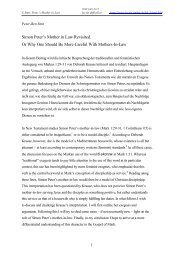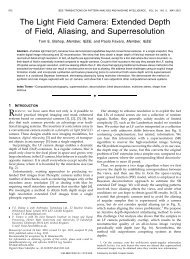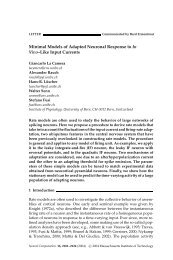Bernese GNSS Software Version 5.2 Tutorial
Bernese GNSS Software Version 5.2 Tutorial
Bernese GNSS Software Version 5.2 Tutorial
- No tags were found...
Create successful ePaper yourself
Turn your PDF publications into a flip-book with our unique Google optimized e-Paper software.
3 Terminal Session: Pole and OrbitPreparation (Monday/Tuesday)The terminal session on pole and orbit preparation is to:1. generate the pole information file in the <strong>Bernese</strong> format (POLUPD)2. generate tabular orbit files from CODE precise files (PRETAB)3. generate the <strong>Bernese</strong> standard orbit files (ORBGEN)You should start with these tasks during the Monday’s terminal sessions and finishthe processing during the terminal session on Tuesday.Introductory RemarkWe recommend to use the final or preprocessed products from CODE because they containconsistent orbits for GPS and GLONASS. They also include all active <strong>GNSS</strong> satellites(even if they are unhealthy or during GPS satellite repositioning events) with thehighest possible accuracy thanks to three–day long–arc technology. Due to this choiceyou will get the best possible consistency between the external products and the software.You may alternativly use the products from IGS. Seperate product files for GPS andGLONASS orbits exist from independent combination procedures that first need to bemerged for a multi–<strong>GNSS</strong> processing. For most of the applications, merging the preciseorbit files is sufficient — a tutorial on the procedure is given in Sect. 7.1 of this book.On the other hand, the consistency of the orbits can not be as good as that of CODE (orother analysis center) following the strategy of the rigorous combined processing of GPSand GLONASS measurements for orbit determination.3.1 Prepare Pole InformationTogether with the precise orbit files (PRE), a consistent set of Earth orientation informationis provided in the ORB directory. Whereas the orbits are given in daily files the EOP areavailable in weekly files for the final product series from the CODE analysis center. Wehave to convert the information from the International Earth Rotation and ReferenceSystems Service (IERS)/IGS standard format (file extension within the <strong>Bernese</strong> <strong>GNSS</strong><strong>Software</strong> is IEP) into the internal <strong>Bernese</strong> EOP format (file extension within the <strong>Bernese</strong><strong>GNSS</strong> <strong>Software</strong> is ERP). This is the task of the program POLUPD ("Menu>Orbits/EOP>HandleEOP files>Convert IERS to <strong>Bernese</strong> Format") which is also able to update the EOP records of anexisting file.Page 17
















